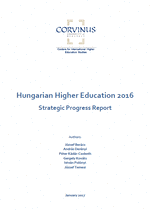Strategic Progress Report 2016
Hungarian Higher Education 2016
Strategic progress report
Written by: József Berács, András Derényi, Péter Kádár-Csoboth, Gergely Kováts, István Polónyi, József Temesi
January, 2017
ISSN 2064-765468 pages

The publication can be downladed (in English) here.
Content
- The strategic focuses of higher education: 2015-2016
- The economic context of the Hungarian higher education
- Changes in the institutional structure and management
- Admission trends in higher education
- Some characteristics of graduate employment
- Changes in qualifications and study programmes; the development of teaching and learning The models of dual education and its situation in Hungary
- Research performance in higher education
- Student mobility and foreign students in the Hungarian higher education
The next edition of our strategic progress reports evaluates the priority areas of the Hungarian higher education in relation to the developments of the years of 2015 and 2016. Following the pattern of the previous reports, the authors of the individual chapters will outline past trends and potential future consequences in the context of the current events. While in our last analysis we put certain areas into an international context by presenting several detailed international comparisons , this time we will primarily focus on the current situation in Hungary. Our study is constituted by the material previously sent to the participants of the “Hungarian Higher Education” conference held on 26 January 2017, completed by the presentations of the speakers followed by a discussion.
At the beginning of our report – in accordance with our established routine –, we provide an overview of the most important claims stated in the individual chapters. However, the picture will only be complete with the figures and analyses presented in the chapters. After the introductory chapter on educational policy, our report touches upon three major areas. First we take a look at the most recent developments of the institutional structure and management as well as the economic conditions of the Hungarian higher education. Wherever possible, we present the practices in place through figures or surveys, contrasting them with government expectations. In the next big block, we examine the situation on the national as well as on the institutional level in light of the admission data and analyse some figures in relation to graduate employment before moving on to the detailed discussion of the issue of qualifications and learning and teaching, including dual education. Finally, the analysis of domestic and international data regarding researcher performance and student mobility allow for international comparison.
Our report intends to offer some claims for consideration for both educational policy makers and heads of institutions. At the same time, we have also tried to formulate our chapters in a way so as to make our message comprehensible for a readership interested in, but less familiar with higher education.
The year of 2017 – as a pre-election year – will definitely have a few surprises up its sleeve. According to one of the dimensions of our report, we look forward to finding out whether the wide-ranging measures launched in 2015/2016 (which perhaps intervened somewhat excessively in the functioning of the institutions) will be able to reverse the trends that have been established over the years, influence seemingly entrenched practices and bring the Hungarian higher education closer to the international cutting edge. Although most of our authors are rather sceptical or at least cautious in that respect, we still hope that at our January 2018 conference and in the progress report to be published then, we will be able to report about coherent examples of the results of educational policy interventions.